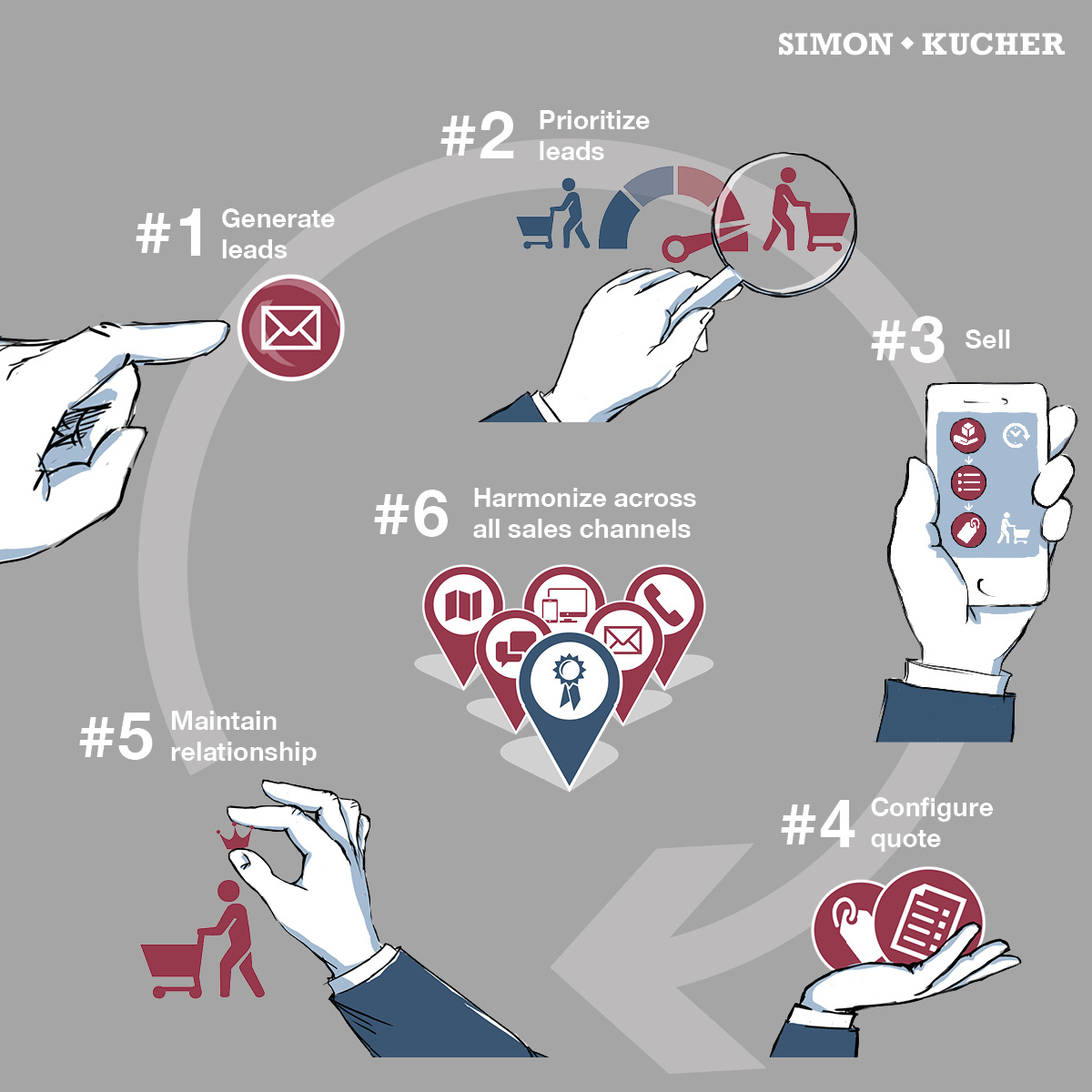There was a time when sales professionals were the go-to experts before almost every sale and the products they sold were just physical. But with digitalization transforming almost every aspect of sales, even the most experienced sales reps can find themselves overwhelmed. The new age requires new tools. That’s why in this series, we cover the essentials for a sales excellence toolkit. In part 1, we explain how state-of-the-art sales technologies and tools can help your sales organization do what they do best: selling.
Applying data-driven sales approaches takes the guesswork out of sales. It provides sales professionals with the confidence to succeed in the field. How can you provide your team with the insights and tools to function as a powerful growth engine? Don’t operate on gut-driven decision-making alone. Here are a few examples how state-of-the-art technologies can be used to enhance steps of the sales process. And ultimately help your sales teams close more deals:
1. Generate great leads
Great leads bring great business, and new technologies are bringing many new ways to target customers. In the past generating leads involved hours of knocking on businesses’ doors, scheduling meetings, making cold calls, and trying to get put through to someone’s superior. Thanks to today’s tools, new customers are just one click away, and you can use tools to effectively structure your commercial process. Not only do you have all the relevant data for each prospect/account to be best equipped for a sale, artificial intelligence can give guidance on which visits will generate most revenue. Benchmarking within the organization can give your company the insight on individual, country, and regional performance.
If your reps have to do a lot of cold outreach, one way of efficiently generating leads is through automated email campaigns. Tools can verify email addresses and create personalized emails (using an AI email assistant) emails to the leads generated, and send them directly from your browser within seconds. Campaign management and segmentation tools plan campaigns and automatically carry out tailored marketing activities for your different customer segments. Nowadays it is also common practice to invite site visitors to subscribe for newsletters via your website. In exchange for their contact data, potential customers receive informative content related to your product or services. You can monitor and analyze the return of these content marketing activities using Analytics and ROI tracking tools.
2. Prioritize leads to focus on top revenue-generating opportunities
Whether sourced through the sales professional’s own efforts, an inbound lead, or a referral, there’s a better way to follow up on leads than just tackling those that first arrive in the pipeline. Tools enable the sales team to work more strategically and concentrate on the high-level leads that are most likely to convert into actual sales. Artificial intelligence uses past data to organize leads by their predicted success and assign ratings based on criteria such as size, segment, country, and industry. While lead scoring calculates the expected worth of each customer and helps sales reps determine whether leads are hot or not, powerful lead trajectory and territory management reports are automatically generated based on data captured during entire sales process. These reports provide valuable insights to further improve lead prioritization and nurturing.
3. Provide sales guidance in customer interactions
Many of today’s sales people are supported by digital tools as they sell. Based on AI, machine learning, and behavioral science, tablets and tailor-made apps generate product recommendations and configurations, value-selling arguments, and price guidance in real time. These tools can be used in a wide range of industries, both B2B and B2C. Indeed a successful B2B sales strategy is increasingly reliant on the same types of tools that are already proven to deliver great results when implemented to win over modern consumers. They are particularly popular with complex products or services, and in the insurance and finance sectors. Sales reps can also easily document interactions with their customers, including changes and milestones that impact buying behavior. For example, becoming a parent may increase the likelihood of a customer buying life insurance. New environmental regulations may mean a manufacturer has an increased interest in green products. This additional sales direction ensures a top customer experience and creates excellent up-and cross-selling opportunities.
4. Accelerate and simplify the quote configuration process
Not only is quoting time-consuming for sales reps, speed-to-quote is also a top pain point for customers. Digitized quoting processes such as Configure Price Quote Solutions (CPQ) can support the sales process by providing a uniform structure and automating workflows. Reps get instant quotes with accurate prices, which can be sent to decision makers for approval, and then on to the client. They simplify and accelerate the approval process with sales managers, and ensure reps spend more time on selling than repetitive tasks.
5. Maintain long-lasting customer relationships
Customers are a company’s main asset. However, many still rely on address books and spreadsheets to manage and track even hundreds of customers. To effectively maintain long-lasting customer relationships, technology can facilitate customer service and interactions across all channels – for companies of any size and category. Software can record customer preferences, spending patterns etc. and link all of this relevant information to tap into personalized up- and cross-selling opportunities. Self-service components can also be included in the selling process, giving the customers the option to upgrade or upsell themselves. CRM platforms offer ways to easily share and collaborate on customer data across departments to improve service quality to customer.

6. Remember: Harmonize the sales process
Navigating the complex world of sales tools can be a tricky task, but for customers, it is all about the journey. They expect to experience a seamless customer journey via all sales channels and touchpoints. Analyze where and when they want to interact with you in the online ecosystem. Can you tailor the offerings even early on to meet target group expectations and increase your sales conversion?
How can you identify the best tools available on the market? Derive concepts for individual software or extensions to existing systems? This requires an expert with a deep understanding of sales processes and extensive knowledge of digital solutions. It has never been more important to develop tailored sales solutions for your business. Only with the right experience on your side can these solutions enhance sales force effectiveness and grow your business.
Read more from our sales excellence toolkit:
Part 1: Incentivize Your Sales Team With a Smart Sales Compensation Structure
